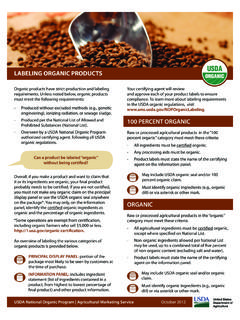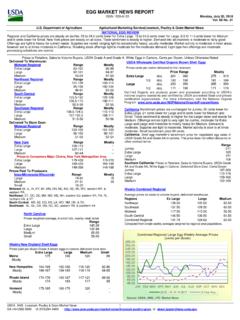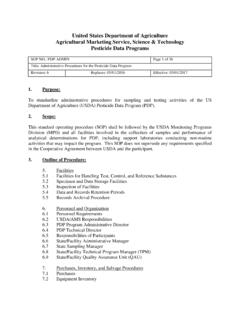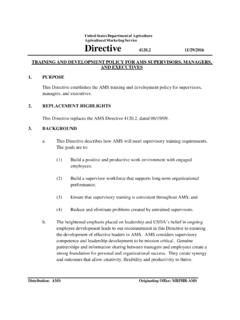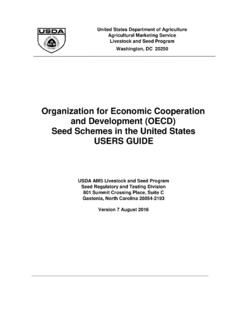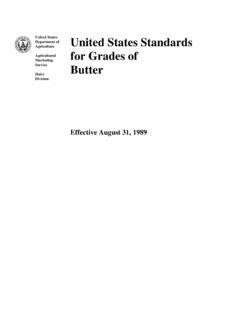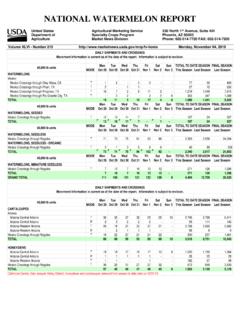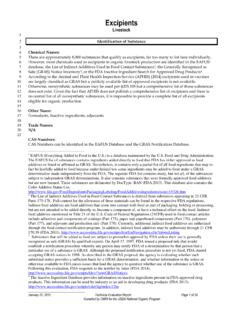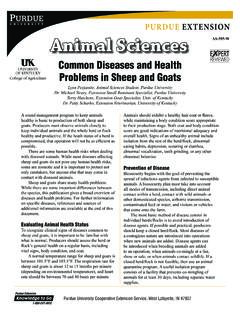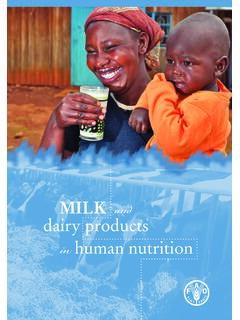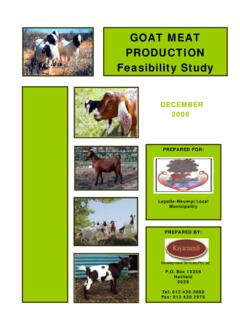Transcription of Milk for Manufacturing Purposes and its Production and ...
1 United States Department of Agriculture Milk for Manufacturing Agricultural Marketing Purposes and its Service Dairy Production and Processing Programs Recommended Requirements Effective July 21, 2011. 0. Subpart A - Sample State Enabling Act An act to provide for the establishment of requirements for milk for Manufacturing Purposes and its Production and processing. SECTION 1. It is the intent of the Act to encourage the sanitary Production of good quality milk, to promote the sanitary processing of milk for Manufacturing Purposes , and to assure wholesome, stable, and high-quality dairy products. Sec. 2. The (regulatory agency of the State)1 shall administer the provisions of this Act and is hereby authorized: to establish and promulgate rules and regulations for milk for Manufacturing Purposes , its Production , transportation, grading, use, processing, and the packaging, labeling and storage of dairy products made therefrom; to inspect dairy farms and dairy plants; to certify dairy farms for the Production and sale of milk for Manufacturing Purposes and to license dairy plants to handle and process milk for Manufacturing Purposes , in conformity with basic requirements and specifications prescribed by such rules and regulations as may be issued hereunder in effectuation of the intent hereof; to require the keeping of appropriate books and records by plants licensed hereunder; and to license qualified milk graders and bulk milk collectors.
2 Sec. 3. The (regulatory agency of the State)1 may for good cause, after notice and opportunity for hearing, suspend or revoke certification and licenses issued hereunder. Provided, that nothing in this Act shall be construed to prevent the suspension of the operation of any plant prior to a hearing, when such action is authorized by any applicable and valid law or regulation. Sec. 4. Twenty-four months from and after the effective date of the rules and regulations issued pursuant to this Act, no person, firm, or corporation shall produce, sell, offer for sale, or process milk for the manufacture of human food except in accordance with the provisions of this Act and the rules and regulations issued pursuant hereto. Sec. 5. Any person, firm, or corporation that willfully violates any provision of this Act or the rules and regulations issued pursuant hereto shall be fined not more than $___, and each and every violation shall constitute a separate offense.
3 Sec. 6. This Act shall become effective _____. 1. Insert name of appropriate regulatory agency, official, or department. 1. Subpart B - Definitions SECTION B1. Meaning of words. Words used in the singular form shall be deemed to import the plural, and vice versa, as the case may demand. Sec. B2. Terms defined. Unless the context otherwise requires, the following terms shall be construed, respectively, to mean: (a) Act. (The State Act to provide for the establishment of Requirements for Milk for Manufacturing Purposes and Its Production and Processing.)1. (b) Regulatory agency. (Insert the name of the State agency, official, or department) is authorized by law to administer the Act. (c) Rules and regulations. The provisions of Subpart B to F herein. (d) License. A license issued under the Act by (the regulatory agency). (e) Fieldperson. A person qualified and trained in the sanitary methods of Production and handling of milk as set forth herein, and generally employed by a processing or Manufacturing plant for the purpose of making dairy farm surveys and doing quality control work.
4 (f) Fieldperson, approved. A fieldperson qualified, trained, and approved by the (regulatory agency) to perform farm inspections and raw milk grading. (g) Inspector. A qualified, trained person employed by (the regulatory agency) to perform dairy farm or plant inspections and raw milk grading. (h) Milk grader or bulk milk collector. A person licensed by (the regulatory agency) as described in F (b) who is qualified and trained for the grading of raw milk in accordance with the quality standards and procedures of Subparts C and F. (i) Producer. The person or persons who exercise control over the Production of the milk delivered to a plant, and who receives payment for this product. A "new producer" is one who is initiating the shipment of milk from a farm. A "transfer producer" is one whose shipment of milk from a farm is shifted from one plant to another plant. A "producer/processor" is one who manufactures dairy products on the dairy farm entirely from his own milk, or from his own milk combined with milk from one or more other producers.
5 (j) Dairy farm or farm. A place or premise where one or more lactating animals are kept, and from which all or a portion of the milk produced thereon is delivered, sold, or offered for sale to a Manufacturing plant. (k) Dairy plant or plant. Any place, premise, or establishment where milk or dairy products are received or handled for processing or Manufacturing and/or prepared for 2. distribution. When "plant" is used in connection with the Production , transportation, grading, or use of milk, it means any plant that handles or purchases milk for Manufacturing Purposes ; when used in connection with requirements for plants or licensing of plants, it means only those plants that manufacture dairy products. (l) Milk. The term "milk" shall include the following. (1) Milk is the lacteal secretion practically free from colostrum obtained by the complete milking of one or more healthy cows.
6 (2) goat milk is the lacteal secretion practically free from colostrum obtained by the complete milking of one or more healthy goats. goat milk shall only be used to manufacture dairy products that are legally provided for in 21 CFR or recognized as non-standardized traditional products normally manufactured from goat milk. (3) Sheep milk is the lacteal secretion practically free from colostrums obtained by the complete milking of one or more healthy ewes. Sheep milk shall be produced according to the sanitary standards of this ordinance. (4) Water buffalo milk is the normal lacteal secretion practically free of colostrums, obtained by the complete milking of one or more healthy water buffalo. Water buffalo milk shall be produced according to the sanitary standards of this ordinance. (5) Lactating animals are cows, goats, sheep, and water buffalo producing milk for Manufacturing Purposes .
7 (6) The word "milk" used herein includes only milk, goat 's milk, sheep's milk, and water buffalo milk for Manufacturing Purposes . (m) Milk for Manufacturing Purposes . Milk produced for processing and Manufacturing into products for human consumption but not subject to Grade A or comparable requirements. (n) Acceptable milk. Milk that qualifies under sec. C2 as to sight and odor and that is classified No. 1 or No. 2 for sediment content (sec. C3.). (o) Probational milk. Milk classified No. 3 for sediment content that may be accepted by plants for not over 10 days (sec. C3.). (p) Rejected milk. Milk rejected from the market according to the provisions of sec. C5. (q) Excluded milk. All of a producer's milk excluded from the market by the provisions of sec. C7. (r) Dairy products. Butter, cheese (natural or processed), dry whole milk, nonfat dry milk, dry buttermilk, dry whey, evaporated milk (whole or skim), condensed whole milk and condensed skim milk (plain or sweetened), and such other products, for human consumption, as may be otherwise designated.
8 (s) Farm certification. Certification by an inspector or approved fieldperson that a producer's herd or flock, milking facility and housing, milking procedure, cooling, milkhouse or 3. milkroom, utensils and equipment and water supply have been found to meet the applicable requirements of subpart D for the Production of milk to be used for Manufacturing Purposes . (t) Official methods. Official Methods of Analysis of the Association of Official Analytical Chemists (AOAC), a publication of the Association of Official Analytical Chemists International, 481 North Frederick Avenue, Suite 500, Gaithersburg, MD 20877-2417. (u) Standard methods. Standard Methods for the Examination of Dairy Products , a publication of the American Public Health Association, 1015 Fifteenth Street, NW, Washington, (v) 3-A Sanitary Standards. The latest standards for dairy equipment and accepted practices formulated by the 3-A Sanitary Standards Committees representing the International Association of Food Protection, the Federal Food and Drug Administration, and the Dairy Industry Committee.
9 These standards are published by the International Association of Food Protection, 6200 Aurora Avenue, Suite 200 W, Des Moines, IA 50322-2863. (w) C-I-P or cleaned-in-place. The procedure by which sanitary pipelines or pieces of dairy equipment are mechanically cleaned in place by circulation. (x) Atmosphere relatively free from mold. No more than 10 mold colonies per cubic foot of air as determined in Standard Methods. (y) Sanitizing treatment. Subjection of a clean surface to steam, hot water, hot air, or an acceptable sanitizing solution for the destruction of most human pathogens and other vegetative microorganisms to a level considered safe for product Production . Such treatment shall not adversely affect the equipment, the milk, the milk product or the health of consumers. Sanitizing solutions shall comply with 21 CFR Subpart C - Quality Requirements for Milk for Manufacturing Purposes Sec.
10 C1. Basis. The quality classification of raw milk for Manufacturing Purposes from each producer shall be based on an organoleptic examination for appearance and odor, a drug residue test and quality control tests for sediment content, bacterial estimate and somatic cell count. Sec. C2. Appearance and odor. The appearance of acceptable raw milk shall be normal and free of excessive coarse sediment when examined visually or by an acceptable test procedure. The milk shall not show any abnormal condition (including but not limited to curdles, ropy, bloody or mastitic condition), as indicated by sight or other test procedures. The odor shall be fresh and sweet. The milk shall be free from objectionable feed and other off-odors that would adversely affect the finished product. 4. Sec. C3. Sediment content classification. Milk shall be classified for sediment content, regardless of the results of the appearance and odor examination described in Sec.
